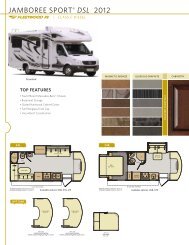Create successful ePaper yourself
Turn your PDF publications into a flip-book with our unique Google optimized e-Paper software.
visually if it is a front tire . If it is an outside<br />
rear dual, you might also spot it with a visual<br />
inspection . However, if it is an inside rear dual,<br />
the chances of spotting it without an air pressure<br />
check are very slim . If you begin driving<br />
without finding it, very quickly (in most cases a<br />
few miles) your outside rear tire next to the low<br />
air pressure tire is going to heat up from carrying<br />
double its load, which, if left unremedied will<br />
eventually cause both tires to fail .<br />
Tire Replacement<br />
Replacement tires must be the same size, type<br />
and tread depth per axle, and have at least the<br />
same weight carrying capacity as the original<br />
equipment . Tires supplied by various manufacturers<br />
of the same size and rating may not<br />
have the same weight carrying capacity and<br />
maximum cold inflation pressures. Consult<br />
your tire dealer . The original equipment wheels<br />
and tires supplied on your motor home have<br />
weight carrying capacities to support Gross<br />
Axle Weight Ratings (GAWR) as stated on the<br />
Federal Certification Tag attached in the driver’s<br />
compartment .<br />
Per Department of Transportation regulations all<br />
tires are to be “stamped” with their weight rating,<br />
size, maximum inflation pressure and manufacturing<br />
date . Use this information to assist in<br />
tire replacement .<br />
Tire Rotation<br />
Your tires can be rotated for increased tire wear .<br />
The front tires should only be rotated side-toside<br />
only and never front to back . The rear tires<br />
should only be rotated side-to-side only and<br />
never front to back . Seek professional help with<br />
tire rotation at an authorized dealership .<br />
If You Get a Flat Tire<br />
In case of sudden tire failure:<br />
3<br />
NOTE<br />
On The Road<br />
The motor home will tend to “pull” toward the side with<br />
the flat tire.<br />
• Apply the accelerator to maintain directional<br />
stability, then gradually release the<br />
accelerator.<br />
• Use moderate brake pedal pressure.<br />
Do not pump the brake. The vehicle is<br />
equipped with Anti-lock Brakes (ABS)<br />
which will help control braking.<br />
• Firmly hold the steering wheel while<br />
avoiding abrupt steering inputs and move<br />
slowly to a safe place.<br />
• Park on a firm level surface.<br />
• Turn off the ignition.<br />
• Set the parking brake.<br />
• Turn on the hazard flasher system.<br />
• Ensure your passengers are safely located<br />
and children monitored.<br />
• Get professional roadside assistance.<br />
Changing a Flat Tire<br />
Even with good tire maintenance and normal<br />
driving, you may experience a flat tire. Summon<br />
professional help through your auto club, travel<br />
service, or a local truck service facility . Your<br />
motor home is not equipped with a jack or<br />
other lifting device . Do not attempt to lift the<br />
motor home with a jack . Consult the Chassis<br />
Operator’s/Owner’s Guide/ Manual for additional<br />
information on tire inflation and proper<br />
torque or the leveling system .<br />
!<br />
CAUTION<br />
Wheels and tires equipped with your motor home are<br />
extremely heavy and may weigh 100 pounds or more.<br />
Do not attempt to remove the spare tire (if equipped)<br />
unless you are capable of handling the weight.<br />
05-11






